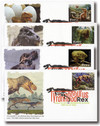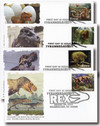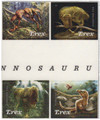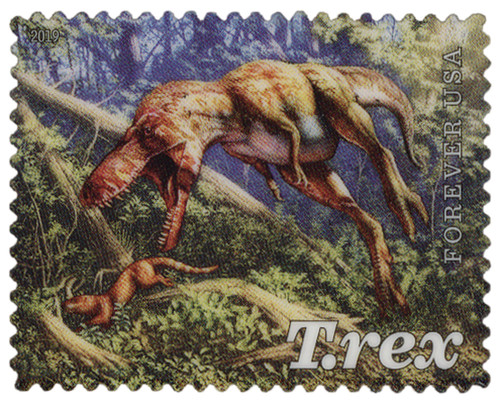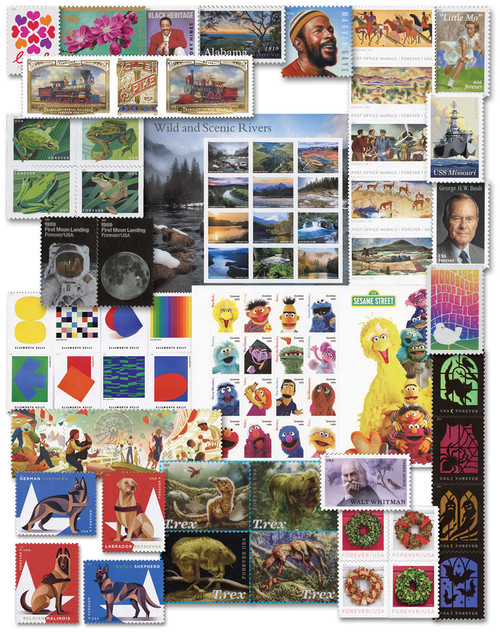
# 5410-13 - 2019 First-Class Forever Stamps - Tyrannosaurus Rex
US #5410-13
2019 Tyrannosaurus Rex
- Four stamps issued to coincide with the opening of a new rex exhibit at the Smithsonian National Museum of Natural History.
Stamp Category: Commemorative
Value: 55¢ First Class Mail Rate (Forever)
First Day of Issue: August 29, 2019
First Day City: Washington, DC
Quantity Issued: 50,000,000
Printed by: Banknote Corporation of America
Printing Method: Flexographic, Lenticular
Format: Panes of 16
Tagging: Phosphor, block tagged
Why the stamps were issued: To commemorate one of the most famous dinosaurs in history – the Tyrannosaurus Rex.
About the stamp designs: Each of the four stamp designs pictures a different image of Tyrannosaurus Rex. Original artwork by Julius T. Csotonyi, a scientist and paleoartist.
First Day City: The First Day of Issue Ceremony was held at the Smithsonian National Museum of Natural History.
History the stamp represents: In 2019, the Smithsonian National Museum of Natural History intoruduced a new Tyrannosaurus rex exhibit. It featured the specimen known as the “Nation’s T. rex,” feeding on a Triceratops.
The Nation’s T. rex was discovered in Fort Peck Reservoir, Montana, in 1988 by rancher Kathy Wankel. The Tyrannosaurus rex was originally named the “Wankel rex” and was excavated by paleontologist Jack Horner and his team. The dig took two years, after which the dinosaur was moved to Montana’s Museum of the Rockies. In 2014, the Smithsonian secured a 50-year contract allowing them to display the Wankel rex in Washington, DC.
The National Museum of Natural History sent the fossilized bones to Research Casting International in Ontario, Canada. The Tyrannosaurus rex skeleton spent four years there, where it was built a custom metal display frame for its return to Washington. At the same time, the Smithsonian was also updating the David H. Koch Hall of Fossils – Deep Time.
On June 8, 2019, both the Nation’s T. rex exhibit and the renovated fossil hall were opened to the public for the first time. In honor of the event, the USPS released a set of four Tyrannosaurus rex Forever stamps. They were fitting tributes to this unforgettable and influential dinosaur.
US #5410-13
2019 Tyrannosaurus Rex
- Four stamps issued to coincide with the opening of a new rex exhibit at the Smithsonian National Museum of Natural History.
Stamp Category: Commemorative
Value: 55¢ First Class Mail Rate (Forever)
First Day of Issue: August 29, 2019
First Day City: Washington, DC
Quantity Issued: 50,000,000
Printed by: Banknote Corporation of America
Printing Method: Flexographic, Lenticular
Format: Panes of 16
Tagging: Phosphor, block tagged
Why the stamps were issued: To commemorate one of the most famous dinosaurs in history – the Tyrannosaurus Rex.
About the stamp designs: Each of the four stamp designs pictures a different image of Tyrannosaurus Rex. Original artwork by Julius T. Csotonyi, a scientist and paleoartist.
First Day City: The First Day of Issue Ceremony was held at the Smithsonian National Museum of Natural History.
History the stamp represents: In 2019, the Smithsonian National Museum of Natural History intoruduced a new Tyrannosaurus rex exhibit. It featured the specimen known as the “Nation’s T. rex,” feeding on a Triceratops.
The Nation’s T. rex was discovered in Fort Peck Reservoir, Montana, in 1988 by rancher Kathy Wankel. The Tyrannosaurus rex was originally named the “Wankel rex” and was excavated by paleontologist Jack Horner and his team. The dig took two years, after which the dinosaur was moved to Montana’s Museum of the Rockies. In 2014, the Smithsonian secured a 50-year contract allowing them to display the Wankel rex in Washington, DC.
The National Museum of Natural History sent the fossilized bones to Research Casting International in Ontario, Canada. The Tyrannosaurus rex skeleton spent four years there, where it was built a custom metal display frame for its return to Washington. At the same time, the Smithsonian was also updating the David H. Koch Hall of Fossils – Deep Time.
On June 8, 2019, both the Nation’s T. rex exhibit and the renovated fossil hall were opened to the public for the first time. In honor of the event, the USPS released a set of four Tyrannosaurus rex Forever stamps. They were fitting tributes to this unforgettable and influential dinosaur.




